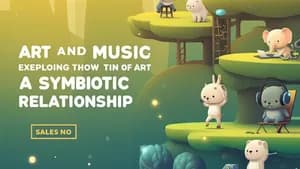Introduction: The Unexpected Harmony of Art and Music
Have you ever watched a painter spontaneously add a splash of unexpected color to a canvas, transforming the entire piece? Or listened to a jazz musician weave a captivating melody from seemingly random notes? These moments, born from improvisation, reveal the boundless creative potential within us. Improvisation, often associated with music, particularly jazz, is a powerful tool that transcends genres, finding its expression equally in visual arts, writing, and even problem-solving. This article will explore the exciting intersection of improvisation in art and music, illustrating how this spontaneous approach unlocks creativity and fosters deeper learning.
Understanding Improvisation: Beyond Spontaneity
Improvisation isn't simply about doing something without a plan. It's a structured form of creativity that relies on foundational skills and a deep understanding of the medium. In music, a jazz musician needs to know harmony, rhythm, and melody to improvise effectively. Similarly, a painter needs to understand color theory, composition, and brushstrokes to create spontaneous yet meaningful artwork. Think of improvisation as a conversation – you need to understand the language before you can engage in a meaningful exchange.
For students, this means focusing on building a strong foundation in their chosen art forms. If you're learning painting, practice mastering different techniques, experiment with color mixing, and study the works of masters. If you're learning music, focus on developing your technique, understanding musical theory, and listening critically to various genres. This foundational knowledge provides the vocabulary for your improvisational explorations. Don't be afraid to experiment; each ‘mistake’ is an opportunity to learn and refine your approach.
Improvisation in Music: A Journey of Sound
Jazz music exemplifies the power of musical improvisation. Imagine a group of musicians, each responding to the others' musical ideas, weaving a unique tapestry of sound in real time. The beauty lies not only in the spontaneous creation but also in the collaboration and mutual respect between the artists. Each musician listens intently, building upon and reacting to the contributions of others. It is a dynamic interplay that creates something fresh and exciting every time.
You can apply this collaborative spirit to your own musical learning. If you're working on a musical piece with others, try incorporating improvisation exercises. Start with a simple melody and allow each person to add their own variations. Even solo practice can benefit from improvisation: try improvising a melody over a chord progression or experimenting with different rhythms and styles. The key is to allow yourself to explore and discover what emerges spontaneously.
Improvisation in Visual Arts: Unleashing Creative Potential
In visual arts, improvisation takes the form of spontaneous mark-making, intuitive composition, and unexpected layering of colors and textures. Think of abstract expressionism, where artists like Jackson Pollock allowed their emotions and instincts to guide their brushstrokes, resulting in powerful and evocative works. This doesn't mean abandoning any planning whatsoever; it's about creating a space for the unexpected to happen within a framework of artistic understanding.
As a student, try incorporating improvisation into your art practice. Start with a sketch and then let your intuition guide you as you add color and texture. Don’t worry about creating a “perfect” piece. Instead, focus on the process of exploration and discovery. You can even start with a simple exercise: choose a single color and explore its various shades and textures through different techniques. Allow yourself to make mistakes; it's through experimentation that you'll discover new approaches and uncover your unique artistic voice.
Bridging the Gap: Improvisation as a Learning Strategy
The principles of improvisation extend far beyond art and music. This approach to learning fosters adaptability, problem-solving skills, and creative thinking. In any subject, the ability to approach a challenge spontaneously and creatively is invaluable. Imagine working on a complex math problem: instead of getting stuck on a single approach, try improvising – explore different strategies, combine concepts, and don’t be afraid to experiment. The same applies to writing essays, solving scientific problems, or even navigating social situations.
By encouraging improvisation in various aspects of your learning, you're not only enhancing creativity but also building resilience. The ability to adapt to unexpected challenges is a crucial skill for success in any field. It encourages a growth mindset, where mistakes are seen as opportunities for learning rather than setbacks. One particularly effective strategy is to incorporate ‘improv games’ into your study routine – brainstorming sessions with friends, role-playing different scenarios, or even simply improvising a short story on a particular topic can build critical skills.
Conclusion: Embracing the Power of Spontaneity
Improvisation, whether in music, art, or any other field, offers a powerful pathway to unlocking creativity, problem-solving skills, and self-expression. By embracing spontaneity and allowing for the unexpected, you open yourself up to a world of possibilities. The key lies in building a solid foundation in your chosen field, understanding the underlying principles, and then allowing yourself to explore the exciting realm of unplanned creation. This journey of spontaneous exploration is not only incredibly rewarding but also enhances learning in ways that structured approaches often cannot match. It allows you to develop a unique style and discover your own creative voice, leading to a deeper understanding and appreciation of the art form and its boundless potential. Remember, the process is just as important as the outcome, so embrace the journey with confidence and curiosity. Through experimentation and exploration, you'll find the power of improvisation transformative.

